Vassilis Katsouros
MEDUSA: A Multimodal Deep Fusion Multi-Stage Training Framework for Speech Emotion Recognition in Naturalistic Conditions
Jun 11, 2025Abstract:SER is a challenging task due to the subjective nature of human emotions and their uneven representation under naturalistic conditions. We propose MEDUSA, a multimodal framework with a four-stage training pipeline, which effectively handles class imbalance and emotion ambiguity. The first two stages train an ensemble of classifiers that utilize DeepSER, a novel extension of a deep cross-modal transformer fusion mechanism from pretrained self-supervised acoustic and linguistic representations. Manifold MixUp is employed for further regularization. The last two stages optimize a trainable meta-classifier that combines the ensemble predictions. Our training approach incorporates human annotation scores as soft targets, coupled with balanced data sampling and multitask learning. MEDUSA ranked 1st in Task 1: Categorical Emotion Recognition in the Interspeech 2025: Speech Emotion Recognition in Naturalistic Conditions Challenge.
Krikri: Advancing Open Large Language Models for Greek
May 19, 2025Abstract:We introduce Llama-Krikri-8B, a cutting-edge Large Language Model tailored for the Greek language, built on Meta's Llama 3.1-8B. Llama-Krikri-8B has been extensively trained on high-quality Greek data to ensure superior adaptation to linguistic nuances. With 8 billion parameters, it offers advanced capabilities while maintaining efficient computational performance. Llama-Krikri-8B supports both Modern Greek and English, and is also equipped to handle polytonic text and Ancient Greek. The chat version of Llama-Krikri-8B features a multi-stage post-training pipeline, utilizing both human and synthetic instruction and preference data, by applying techniques such as MAGPIE. In addition, for evaluation, we propose three novel public benchmarks for Greek. Our evaluation on existing as well as the proposed benchmarks shows notable improvements over comparable Greek and multilingual LLMs in both natural language understanding and generation as well as code generation.
DeepMLF: Multimodal language model with learnable tokens for deep fusion in sentiment analysis
Apr 15, 2025Abstract:While multimodal fusion has been extensively studied in Multimodal Sentiment Analysis (MSA), the role of fusion depth and multimodal capacity allocation remains underexplored. In this work, we position fusion depth, scalability, and dedicated multimodal capacity as primary factors for effective fusion. We introduce DeepMLF, a novel multimodal language model (LM) with learnable tokens tailored toward deep fusion. DeepMLF leverages an audiovisual encoder and a pretrained decoder LM augmented with multimodal information across its layers. We append learnable tokens to the LM that: 1) capture modality interactions in a controlled fashion and 2) preserve independent information flow for each modality. These fusion tokens gather linguistic information via causal self-attention in LM Blocks and integrate with audiovisual information through cross-attention MM Blocks. Serving as dedicated multimodal capacity, this design enables progressive fusion across multiple layers, providing depth in the fusion process. Our training recipe combines modality-specific losses and language modelling loss, with the decoder LM tasked to predict ground truth polarity. Across three MSA benchmarks with varying dataset characteristics, DeepMLF achieves state-of-the-art performance. Our results confirm that deeper fusion leads to better performance, with optimal fusion depths (5-7) exceeding those of existing approaches. Additionally, our analysis on the number of fusion tokens reveals that small token sets ($\sim$20) achieve optimal performance. We examine the importance of representation learning order (fusion curriculum) through audiovisual encoder initialization experiments. Our ablation studies demonstrate the superiority of the proposed fusion design and gating while providing a holistic examination of DeepMLF's scalability to LLMs, and the impact of each training objective and embedding regularization.
Meltemi: The first open Large Language Model for Greek
Jul 30, 2024Abstract:We describe the development and capabilities of Meltemi 7B, the first open Large Language Model for the Greek language. Meltemi 7B has 7 billion parameters and is trained on a 40 billion token Greek corpus. For the development of Meltemi 7B, we adapt Mistral, by continuous pretraining on the Greek Corpus. Meltemi 7B contains up-to-date information up to September 2023. Furthermore, we have translated and curated a Greek instruction corpus, which has been used for the instruction-tuning of a chat model, named Meltemi 7B Instruct. Special care has been given to the alignment and the removal of toxic content for the Meltemi 7B Instruct. The developed models are evaluated on a broad set of collected evaluation corpora, and examples of prompts and responses are presented. Both Meltemi 7B and Meltemi 7B Instruct are available at https://huggingface.co/ilsp under the Apache 2.0 license.
The Greek podcast corpus: Competitive speech models for low-resourced languages with weakly supervised data
Jun 21, 2024Abstract:The development of speech technologies for languages with limited digital representation poses significant challenges, primarily due to the scarcity of available data. This issue is exacerbated in the era of large, data-intensive models. Recent research has underscored the potential of leveraging weak supervision to augment the pool of available data. In this study, we compile an 800-hour corpus of Modern Greek from podcasts and employ Whisper large-v3 to generate silver transcriptions. This corpus is utilized to fine-tune our models, aiming to assess the efficacy of this approach in enhancing ASR performance. Our analysis spans 16 distinct podcast domains, alongside evaluations on established datasets for Modern Greek. The findings indicate consistent WER improvements, correlating with increases in both data volume and model size. Our study confirms that assembling large, weakly supervised corpora serves as a cost-effective strategy for advancing speech technologies in under-resourced languages.
Weakly-supervised Automated Audio Captioning via text only training
Sep 21, 2023
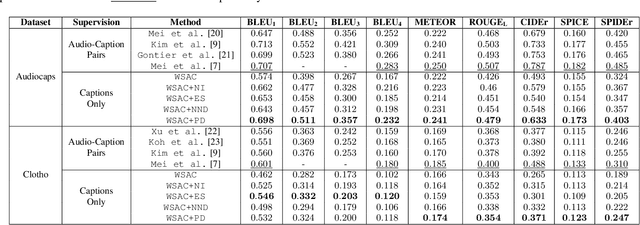
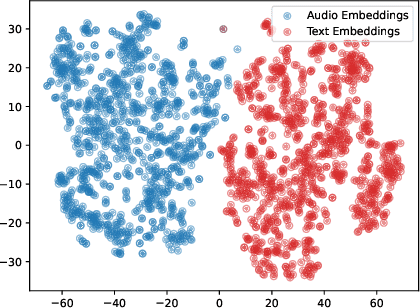

Abstract:In recent years, datasets of paired audio and captions have enabled remarkable success in automatically generating descriptions for audio clips, namely Automated Audio Captioning (AAC). However, it is labor-intensive and time-consuming to collect a sufficient number of paired audio and captions. Motivated by the recent advances in Contrastive Language-Audio Pretraining (CLAP), we propose a weakly-supervised approach to train an AAC model assuming only text data and a pre-trained CLAP model, alleviating the need for paired target data. Our approach leverages the similarity between audio and text embeddings in CLAP. During training, we learn to reconstruct the text from the CLAP text embedding, and during inference, we decode using the audio embeddings. To mitigate the modality gap between the audio and text embeddings we employ strategies to bridge the gap during training and inference stages. We evaluate our proposed method on Clotho and AudioCaps datasets demonstrating its ability to achieve a relative performance of up to ~$83\%$ compared to fully supervised approaches trained with paired target data.
Investigating Personalization Methods in Text to Music Generation
Sep 20, 2023
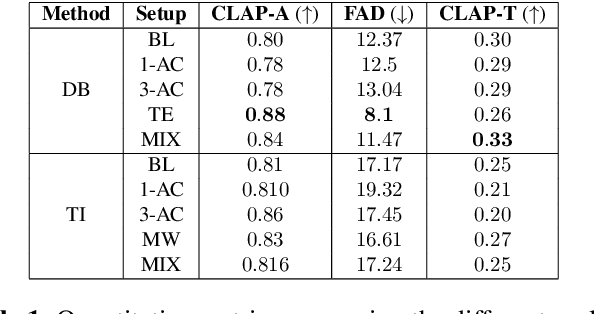
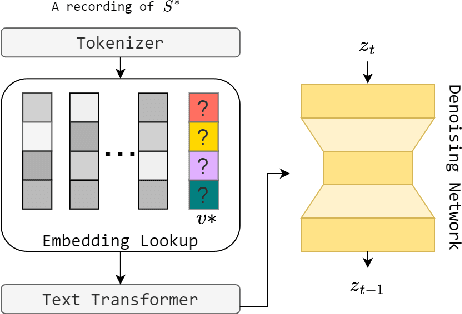

Abstract:In this work, we investigate the personalization of text-to-music diffusion models in a few-shot setting. Motivated by recent advances in the computer vision domain, we are the first to explore the combination of pre-trained text-to-audio diffusers with two established personalization methods. We experiment with the effect of audio-specific data augmentation on the overall system performance and assess different training strategies. For evaluation, we construct a novel dataset with prompts and music clips. We consider both embedding-based and music-specific metrics for quantitative evaluation, as well as a user study for qualitative evaluation. Our analysis shows that similarity metrics are in accordance with user preferences and that current personalization approaches tend to learn rhythmic music constructs more easily than melody. The code, dataset, and example material of this study are open to the research community.
Weakly-supervised forced alignment of disfluent speech using phoneme-level modeling
May 30, 2023Abstract:The study of speech disorders can benefit greatly from time-aligned data. However, audio-text mismatches in disfluent speech cause rapid performance degradation for modern speech aligners, hindering the use of automatic approaches. In this work, we propose a simple and effective modification of alignment graph construction of CTC-based models using Weighted Finite State Transducers. The proposed weakly-supervised approach alleviates the need for verbatim transcription of speech disfluencies for forced alignment. During the graph construction, we allow the modeling of common speech disfluencies, i.e. repetitions and omissions. Further, we show that by assessing the degree of audio-text mismatch through the use of Oracle Error Rate, our method can be effectively used in the wild. Our evaluation on a corrupted version of the TIMIT test set and the UCLASS dataset shows significant improvements, particularly for recall, achieving a 23-25% relative improvement over our baselines.
Sample-Efficient Unsupervised Domain Adaptation of Speech Recognition Systems A case study for Modern Greek
Dec 31, 2022Abstract:Modern speech recognition systems exhibits rapid performance degradation under domain shift. This issue is especially prevalent in data-scarce settings, such as low-resource languages, where diversity of training data is limited. In this work we propose M2DS2, a simple and sample-efficient finetuning strategy for large pretrained speech models, based on mixed source and target domain self-supervision. We find that including source domain self-supervision stabilizes training and avoids mode collapse of the latent representations. For evaluation, we collect HParl, a $120$ hour speech corpus for Greek, consisting of plenary sessions in the Greek Parliament. We merge HParl with two popular Greek corpora to create GREC-MD, a test-bed for multi-domain evaluation of Greek ASR systems. In our experiments we find that, while other Unsupervised Domain Adaptation baselines fail in this resource-constrained environment, M2DS2 yields significant improvements for cross-domain adaptation, even when a only a few hours of in-domain audio are available. When we relax the problem in a weakly supervised setting, we find that independent adaptation for audio using M2DS2 and language using simple LM augmentation techniques is particularly effective, yielding word error rates comparable to the fully supervised baselines.
Regotron: Regularizing the Tacotron2 architecture via monotonic alignment loss
Apr 28, 2022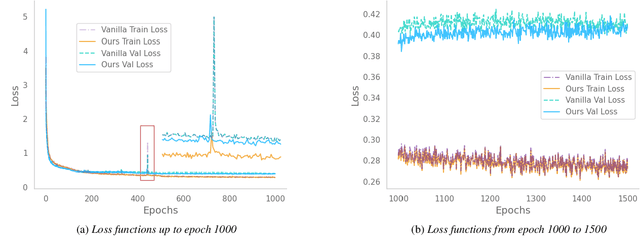
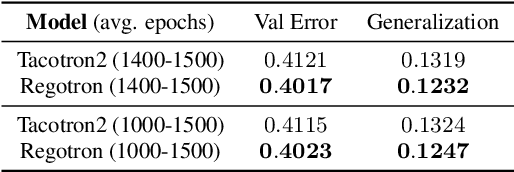


Abstract:Recent deep learning Text-to-Speech (TTS) systems have achieved impressive performance by generating speech close to human parity. However, they suffer from training stability issues as well as incorrect alignment of the intermediate acoustic representation with the input text sequence. In this work, we introduce Regotron, a regularized version of Tacotron2 which aims to alleviate the training issues and at the same time produce monotonic alignments. Our method augments the vanilla Tacotron2 objective function with an additional term, which penalizes non-monotonic alignments in the location-sensitive attention mechanism. By properly adjusting this regularization term we show that the loss curves become smoother, and at the same time Regotron consistently produces monotonic alignments in unseen examples even at an early stage (13\% of the total number of epochs) of its training process, whereas the fully converged Tacotron2 fails to do so. Moreover, our proposed regularization method has no additional computational overhead, while reducing common TTS mistakes and achieving slighlty improved speech naturalness according to subjective mean opinion scores (MOS) collected from 50 evaluators.
 Add to Chrome
Add to Chrome Add to Firefox
Add to Firefox Add to Edge
Add to Edge